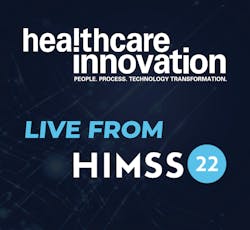At HIMSS22, a Discussion of AI and the Social Determinants of Health
What does it mean to make use of artificial intelligence (AI) and machine learning (ML) in order to examine social determinants of health (SDOH) data in order to improve outcomes and community health? On Monday, March 14 at HIMSS22, during the Machine Learning and AI for Healthcare Forum, one panel of industry leaders considered the issues involved.
The panel, “Leveraging AI to Unearth Social Determinants of Health Risks,” was described in the HIMSS22 program thus: “Unpredictable social risk factors can wreak havoc on providers and payers given the inability to determine the actuarial aspects related to delivery of and payment for care. This panel will study how sophisticated algorithms are being used to predict these risk factors to provide a more personalized and value driven care. Also of great importance, these data analysis strategies can provide incentives to treat the sickest patients in a clinical AI setting.”
Julius Bogdan, vice president, analytics, at HIMSS, moderated the panel. He was joined by Tim Driscoll, senior director, digital health technology strategy, at Boston Children’s Hospital; Michael Dulin, M.D., professor and director at the Academy for Population Health Innovation at the University of North Carolina-Charlotte; and Este Geraghty, M.D., chief medical officer at Esri.
Bogdan initiated the discussion by asking the other panelists directly, “What do the social determinants of health mean to you?”
“I was trained in the medical model as a primary care physician, and it was all about the be-all-and-end-all of the clinic environment; but we know now that the clinical environment only accounts for 20 percent of the health factors involved, and if we want to reduce readmissions and enhance community health, we have to look at the social network of friends and the environment, how people access food,” Dulin said. “So I’ve learned about how we start delivering social services in a way that we improve health.”
And Driscoll said, “Being able to have those insights to participate in appropriate interventions. It’s about finding ways to achieve insights and provide interventions.”
“I’m very biased in that I think that social determinants of health are the same as the structural determinants of health, which are the same as the science of geography,” Geraghy said. “So many determinants are clustered in different ways in our communities; and that’s what the science of geography does; it takes those factors and pulls them out in ways we can make sense of them. And it’s not just one determinant, it’s all of them, and our social context. So how you deal with that level of complexity is very challenging, but it’s what we have to do.”
“How did you move forward on this journey?” Bogdan asked.
“I think this is getting better, but the data we’re collecting on social determinants is often unstructured, or inaccurate,” Dulin noted. “One example of markers we could use, is utilization. There is a bias there, but that can also be used to our advantage. Someone who no-shows frequently might possibly have challenges with childcare or transportation. And there are issues like adherence to medications. Even extremes on patient surveys, such as someone who’s always satisfied with their care, or always dissatisfied. So we should find those markers, as well as parse the data that happens at the geographic level; it might not be perfectly accurate, but can help a lot, particularly if you have no data at all.”
“One ongoing challenge,” Driscoll said, “is that we have incomplete data, including from among patients and families. And we heard in the earlier discussion around bias that your provider may have privilege and not see the challenges in their patients’ lives. So obtaining meaningful information from patients and families; or getting data from a third party. For example, data about food deserts or access to public transportation. So there’s no one in a household with a motor vehicle, and there’s no access to public transportation.”
In that context, he said, “If you’re looking at no-shows—data could help you analyze that. We can also use NLP to obtain certain insights. We’re using AI- and human-generated encounter notes. But also, in a 45-minute appointment, a lot of conversation takes place. So now we’re looking at ways to use speech recognition to analyze conversation. And with the pandemic, we had thousands of new virtual visits. And virtual visits bring up an opportunity to see someone in their home environment; but also facial recognition for emotional states.”
“I became interested in the topic, after clinical encounters, where I’d see a patient and recommend exercise—but a patient might live in a neighborhood where there’s too much crime and it wasn’t safe; or a patient was in a rural area, where there were no sidewalks; or lived in an area with no malls, so one couldn’t recommend mall-walking,” Geraghy said. “And now, payers need to ensure that members have access to primary care and specialists. And now, you can look at the centroid to the patient and the centroid to the provider. And what is the burden of travel? It’s not just geographic time or distance? Are you taking transportation when you have a disability, or can’t pay? So the travel burden is far bigger than just time and distance issues.”
“The famous Camden study confirmed that, absolutely,” Bogdan said. “And we all understand the importance of the social determinants of health, and challenges, and the fact that we don’t collect enough data. So how are you augmenting social determinants of health data, and allying it with clinical data, and using AI to derive insights?”
“One component in this is determining the right interventions based on SDOH data,” Dulin said. “So how do you train the algorithms to address elements? In medicine, we have a lot of clinical knowledge: the patient has hypertension, so the medication is this; but how do you address complex social determinants? Transportation can be addressed with a Lyft ride, but often, it’s more complex than that. And then we have to evaluate our interventions. So it turns out that the no-shows are related to transportation issues, so we provided Lyft coupons; but did that intervention work? And if we’re sending someone to a food pantry, did the person make it to the food pantry? Did that help them in terms of nutrition? What about a1c control?”
All of these elements share commonalities, he said. “And a key element of social determinants of health is to also address health inequities. We see that health inequities are driven by the healthcare system not addressing issues. So it might be a Lyft coupon, a social worker, a case manager, additional outreach, a home health visit, and improved access to telehealth. And then if people don’t have access to broad, for example, could we be adding layers of inequity?”
In fact, Driscoll noted, “Early on in the pandemic, we actually activated a hub spot for patients. So in the end, we need to develop partnerships, and leverage the data not only to identify risk factors, but also to develop effective interventions. Sometimes, the interventions end up being highly specialized. And 20 percent of our patients are international. And putting a solution in place that will involve precise interventions for specific patients—are we going to build something, or partner to create it? I haven’t seen a lot of solutions out there that address those complexities.
The time-sensitivity of the data
Somewhat later on in the discussion, HIMSS’s Bogdan stated, “It’s gotten easier to identify some of the challenges around the social determinants of health, including food insecurity, transportation, housing, etc. So how do you address these issues? Partnerships with community organizations, food pantries, etc. Which factors do you work on first?”
“We need to address the temporal nature of social determinants,” Dulin stressed. “Just because someone has a car today doesn’t mean they’ll have that car tomorrow. And having advanced technology can help us to understand the time-delimited nature of SDOH insights. A made-up word that I like to use is this one—impactability: there’s a period of time during which you can make a difference, and after which it becomes harder to intervene. I think there are a lot of low-hanging opportunities. I was at a large academic medical center, where we developed analytics for kids with asthma, and we developed analytics around SDOH, such as housing issues. In Charlotte now, I’m working with others around HIV prevention. And some of this has to do with, for example, distributing PREP to prevent transmissibility. Charlotte has one of the highest rates of new HIV transmission in the country; we know what the vulnerable population is, it’s men who have sex with men and African-Americans. We need to leverage the data to help us intervene.”
“Taking once again the non-medical data and combining it with the medical data; there’s an opportunity there to leverage data to intervene. And there’s a certain point at which your social determinants of health risk factor, in terms of obtaining high-quality, healthful food, if you’re diabetic—it’s clear that we can take advantage of opportunities early on in patients’ journeys.”
“Yes, the sooner you can intervene, the more you can change patient outcomes,” Bogdan affirmed.
“In our world, we say, don’t make a map just because it’s cool; you need to do something!” Geraghy said. “There’s a simple, low-hanging-fruit way to go, what we call resource locators. I might see a patient and want to refer them to a mental health professional who speaks Spanish, for example. And in the past, I would go to a certain bulletin board to find people. But it doesn’t always work well. With resource integrators, you can intervene more effectively. We worked with a hospital where they developed a wellness map, and patients could refer themselves; this was inside the patient portal in Epic. My favorite part was the part that offered community supports relevant to their clinical condition, such as if they have cancer. And all these resources have been vetted, so the clinician doesn’t have to know who the professionals are, where they are, whether they speak Spanish, for example; it’s all there.”
“As we’re talking about the social determinants of health, we’re talking about data sets from outside healthcare. What are the ethical implications of using this data?”
“The data can be very sensitive, can be stigmatizing,” Dulin said. “I think you always want the patient to be in charge; and make sure patients have the opportunity to opt out. Very few people want to opt out; most people want to use the data to advance health outcomes. But we have to commit to using the data in a way that advances patients’ health and community health. I think putting in place ethical review boards, and such. You also have to be aware that, for example, using hospital employee data, is extremely sensitive.”


